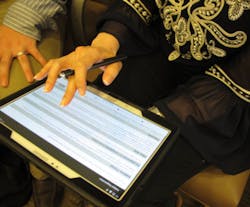Thanks to leadership at NYU Langone Medical Center, trees will be able to sleep a little easier. Clipboards on the other hand? Not so much.
The Manhattan-based academic medical center is on a mission to become completely paperless, says CIO Nader Mherabi. It has an integrated electronic health record (EHR) system, a personal health record (PHR) application that’s offered to every patient, self-service kiosks, and biometric palm scanning technologies. And recently, it took one of the important steps in this journey by rolling out its mobile registration process.
Thanks to a $5 million donation from insurance company AIG, NYU Langone was able to invest in a software system from OnBase by Hyland, a Westlake, Ohio-based company, linking patient registration to its Epic EHR system. The registration software sits on tablets from Samsung, which are given to patients immediately upon entering the facility.
“It’s all about how quickly, through mobility, we can get you through to see a doctor. We want to make this thoroughly mobile, paperless, and convenient,” Mherabi says. “This is a piece of it. The pieces are in motion.”
The paperless registration was first piloted at NYU Langone's Joan H. Tisch Center for Women’s Health, as part of the donor’s request. Nieca Goldberg, M.D., clinical associate professor and medical director at the Joan H. Tisch Center for Women's Health, says that the center has piloted new technologies before and is always willing to take them on.
“I embrace new technology and have a curiosity on how we can use it to improve the patient experience,” says Dr. Goldberg. “Medicine is a pretty conservative profession and people don’t adapt so quickly to change in practice. With the change in the healthcare system, the technology is an integral part.”
The Registration Process
The registration process begins with PatientSecure, NYU Langone’s palm scanning technology. Once they scan their palms, they are then given the Samsung tablet with the registration application. The only forms filled out are the ones haven’t completed and are typical registration questions. The link with the Epic EHR system pre-populates the form with the patient’s name and other information.
The new data from the patient registration application is sent directly back to the EHR where it’s separated for the practitioner to review. The provider can then reconcile that information so by the time they see the patient, it can be addressed. In the near future, Goldberg says patients will be able to ask specific questions about their condition through the app that will be sent to the provider. It’s all about spending more time communicating face-to-face and less time asking questions.
“A lot of the computers are situated in a way that you can’t face the patient. Looking at a patient is very much a part of the assessment. Looking at their cues,” Goldberg says. “That’s when the tablets become very helpful because I can show my patients what’s going on.”
Both Goldberg and Mherabi say the implementation was a smooth collaborative process. Along with the specific vendors, the IT, informatics, and clinical departments, and even patients worked through the process side-by-side. “We got feedback, we had people test it. It was about getting people’s buy-in,” Mherabi says. This included fine tuning and ensuring it wouldn’t hold up the line.
The feedback has been positive. While a small amount of patients have asked for the old paper-based forms, the majority are on board with the tablets and have responded favorably. Goldberg says even patients in their 80s, who communicate with grandchildren via technology, are able to use it without any problems.
Registrars, such as Kathleen Willard, FGP senior assistant at NYU Langone, are happy with the system as well. “When they rolled this out, it was a sigh of relief. I had a huge scan pile,” she says.
Modernizing Healthcare
The registration app has already begun to seep into other areas of the NYU Langone enterprise. Earlier this month, it was rolled out to a large multispecialty practice on Long Island. By the end of 2015, Mherabi says it will be everywhere. When it comes to return on investment, he sees this as implementation as part of a larger “modernizing healthcare” effort.
“In order to modernize healthcare for patients and consumers, these are the building blocks that we have to create. Getting concise information from patients regardless of where they are going is just good healthcare,” says Mherabi, who notes that this is also part of the paperless process. “It’s not good enough to just be in the EMR. It has to be all around.”
In that regard, he calls this kind of application “a must have.” For provider leaders, Goldberg advises they learn as much as they can about the technology and bring their questions. “Often time, you can be instructed to do things faster and better. I wouldn’t want to go back,” Goldberg says.


